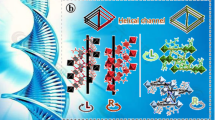Abstract
Mg+2 and Cu+2 have different binding capacities to quinolone drugs and have different binding modes with calf thymus DNA. Using the method of absorption and fluorescence spectroscopy, the influence of Mg+2 and Cu+2 on the binding between calf thymus DNA and each of four quinolone drugs has been studied. The results show that both Mg+2 and Cu+2 can bind with the four drugs. In the absence of divalent metal ions, quinolone drugs interact with DNA double helix by forming hydrogen bonds between the carboxyl and carbonyl groups of the drugs and the phosphate groups of the DNA bases, and the binding capacity shows a close relationship with the drug structures. The two metal ions show different influences on the binding between the drug and DNA, which depends on the type of ion, concentration of the metal ions and the structure of drugs. Mg+2 in lower concentrations (0.01 mM to 3.0 mM) can act as a bridge between the carboxyl group/carbonyl group of the drug and the phosphate group of the DNA by electrostatic interaction, while Cu+2 can act as an intermediary ion between carboxyl group/carbonyl group of the drug and the DNA bases by a co-ordinate bond. Both actions can increase the interaction of the π electron between the condensed rings of the drugs and the DNA bases. In some conditions, Cu+2 can weaken the binding between the drug and the DNA by competitive inhibition if there is a site on the drug that can directly bind both DNA bases and Cu+2.



Similar content being viewed by others
References
Chu DTW, Fernandes PB (1991) In: Testa B (ed.) In Advances in Drug Research, Academic Press, London, vol. 21, pp 42
Reynolds JEF (1993) In Matindale, the extra pharmacopeia, 30th edn. Pharmaceutical, London
Son GS, Yeo JA, Kim MS, Kim SK, Holmen A, Akerman B, Norden B (1998) Binding mode of norfloxacin to calf thmus DNA. J Am Chem Soc 120(26):6451–6457
Anderson VE, Gootz TD, Osheroff NJ (1998) Topoisomerase IV catalysis and the mechanism of quinolone action. J Biol Chem 273(28):17879–17885
Kampranis SC, Maxwell AJ (1998) The DNA gyrase-quinolone complex: ATP hydrolysis and the mechanism of DNA cleavage. J Biol Chem 273(35):22615–22626
Bailly C, Colson P, Houssier C (1998) The orientation of norfloxacin bound to double-stranded DNA. Biomed Biophys Res Commun 243(3):844–848
Song GW, He Y, Cai ZX (2004) The interaction between levofloxacine hydrochloride and DNA mediated by Cu2+. J Fluoresc 14(6):705–710
Shen LL (1989) A reply: do quinolones bind to DNA?- Yes. Biochem Pharmacol 38(12):2042–2044
Morrisey I, Hoshino K, Sato K, Yoshida A, Hayakawa Z, Bures MG, Shen LL (1996) Mechanism of differential activities of ofloxacin enantiomers. Antimicrob Agents Chemother 40(8):1775–1784
Palu G, Valisena S, Ciarrocchi G, Gatto B, Palumbo M (1992) Quinolone binding to DNA is mediated by magnesium ions. Proc Natl Acad Sci USA 89(20):9671–9675
Turel I (2002) The interactions of metal ions with quinolones antibacterial agents. Coord Chem Rev 232(1–2):27–47
Liorente B, Leclerc F, Cedergren R (1996) Using SAR and QSAR analysis to model the activity and structure of the quinolone—DNA complex. Bioorg Med Chem 4(1):61–71
Robles J, Martin-polo J, Alvarez-Valtierra L, Hinojosa L, Mendoza-diaz G (2000) A theoretical-experimental study on the structure and activity of certain quinolones and the interaction of their cu(ii)-complexes on a dna model. Metal Based Drugs 7(6):301–311
Polk RE (1989) Drug-drug interactions with ciprofloxacin andother fluoroquinolones. Am J Med 87:S76–S81
Yuan XY, Chen L, Qiao JL (1999) Study on the ternary complex of CPFX, copper(II) and DNA by the method of fluorescence. Spectrosc Spectral Anal 19(4):572–576
Guo DS, Yuan XY (1999) The regulation of Mg (II) to the combination of ciprofloxacin and calf thymus DNA. Chem J Chin Univ 20(4):584–586
Guo DS, Yuan XY, Wu JB (2007) Influence of Cr(III) and Cr(VI) on the interaction between sparfloxacin and calf thymus DNA. J Inorg Biochem 101(4):644–648
Xie MX, Long M, Liu Y, Qin C (2006) Characterization of the interaction between human serum albumin and morin. Biochim Biophys Acta 1760(8):1184–1191
Xu HJ, Yu JS, Wang SL, Chen HY (2003) Studies on Interactions of Ru(III), Rh(III), Pd(II) with ct-DNA. Chin J Inorg Chem 19(4):355–360
Efthimiadou EK, Thomadaki H, Sanakis Y, Raptopoulou CP, Katsaros N, Scorilas A, Karaliota A, Psomas G (2007) Structure and biological properties of the copper(II) complex with the quinolone antibacterial drug N-propyl-norfloxacin and 2, 20-bipyridine. J Inorg Biochem 101(1):64–73
Author information
Authors and Affiliations
Corresponding author
Rights and permissions
About this article
Cite this article
Dong-Sheng, G., Bo-Yu, J. & Xiao-Ying, Y. Influence of Mg+2 and Cu+2 on the Interaction Between Quinolone and Calf Thymus DNA. J Fluoresc 21, 113–118 (2011). https://doi.org/10.1007/s10895-010-0694-1
Received:
Accepted:
Published:
Issue Date:
DOI: https://doi.org/10.1007/s10895-010-0694-1




